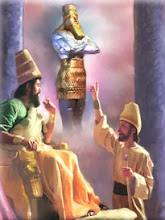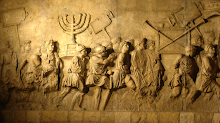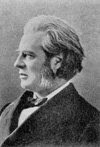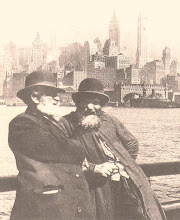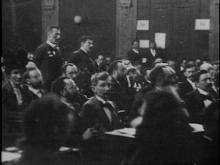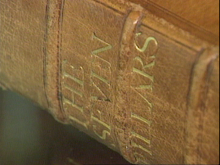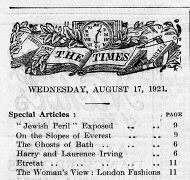Introduction
ONE HUNDRED AND FORTY YEARS BEFORE the actual events came to fruition in the Middle East, two dedicated Bible scholars predicted accurately several key years in the then approaching conflict for tenure of the holy Land and Jerusalem, involving a long prophesised regathering of the Jews to their Promised Land, after nearly 2000 years of Diaspora.
Doctors Clarke and Guinness pointed well in advance to the coming years 1902, 1917, 1947-8 and 1967 AD, having based their predictions on the 2,500 year old Biblical book of Daniel.
Not only did their advance forecasts prove accurate decades later, but those key 'Signpost Years’ continue to mark events and developments in the holy Land, ever since their occurrence in modern times, that now represent the specific themes of serious contention in the struggle for Peace in that region today.
These following NOTES explain the rational behind the Clarke-Guinness thinking in as fast and concise a form as possible, and elaborations will follow. A second critical aim here is not to prove 'The Signpost Years' correct, but rather to use the scientific approach of attempting their falsification first. You can help either way by passing on any objective comments to this site.
PART 1 Is an Introduction and looks at each of the Signpost Years as they were foretold in the writings of Guinness and Clarke. It looks at many of the side issues and has a number of detailed footnotes.
PART 2 Looks at the period 1901 – 1903, and the first of the Signpost Years predicted by Clarke in 1825. This part explains the huge significance of the period and sets the scene for a further link that comes in Part 4.
PART 3 Begins to address some of the typical questions that might arise in the mind of the reader regarding the Signpost Years. Items are added to this from time to time as new considerations are brought to light. Again, feel free to contribute any comments that will add to those pages.
PART 4 Looks at the Signpost Years in the light of the last 6 months of Christ’s Ministry, and especially the last week of messages He imparted to His followers for the future. It ties directly back into PART 2.
*****************************************************
TO READ SPECIFIC 'CHAPTERS' CLICK ONE OF THE 'QUICK LINKS' LISTED DIRECTLY BELOW, AND TO READ OR ADD COMMENTS, CLICK 'POST COMMENT' AT THE END OF EACH CHAPTER THAT WILL OPEN AN EMAIL BOX TO SEND TO THIS BLOG.
AGAIN YOU CAN SIMPLY EMAIL TO:
karl@thesignpostyears.com
Click on QUICK LINKS to Parts 1 to 4 of the Signpost Notes:
Part 1: Introduction, Timelines, Conclusion.
Part 2: The SignPost Year 1902 AD and Max Nordau
Part 3: Q & A on the Signpost Years
Part 4: Jesus and the Signpost Years
Doctors Clarke and Guinness pointed well in advance to the coming years 1902, 1917, 1947-8 and 1967 AD, having based their predictions on the 2,500 year old Biblical book of Daniel.
Not only did their advance forecasts prove accurate decades later, but those key 'Signpost Years’ continue to mark events and developments in the holy Land, ever since their occurrence in modern times, that now represent the specific themes of serious contention in the struggle for Peace in that region today.
These following NOTES explain the rational behind the Clarke-Guinness thinking in as fast and concise a form as possible, and elaborations will follow. A second critical aim here is not to prove 'The Signpost Years' correct, but rather to use the scientific approach of attempting their falsification first. You can help either way by passing on any objective comments to this site.
PART 1 Is an Introduction and looks at each of the Signpost Years as they were foretold in the writings of Guinness and Clarke. It looks at many of the side issues and has a number of detailed footnotes.
PART 2 Looks at the period 1901 – 1903, and the first of the Signpost Years predicted by Clarke in 1825. This part explains the huge significance of the period and sets the scene for a further link that comes in Part 4.
PART 3 Begins to address some of the typical questions that might arise in the mind of the reader regarding the Signpost Years. Items are added to this from time to time as new considerations are brought to light. Again, feel free to contribute any comments that will add to those pages.
PART 4 Looks at the Signpost Years in the light of the last 6 months of Christ’s Ministry, and especially the last week of messages He imparted to His followers for the future. It ties directly back into PART 2.
*****************************************************
TO READ SPECIFIC 'CHAPTERS' CLICK ONE OF THE 'QUICK LINKS' LISTED DIRECTLY BELOW, AND TO READ OR ADD COMMENTS, CLICK 'POST COMMENT' AT THE END OF EACH CHAPTER THAT WILL OPEN AN EMAIL BOX TO SEND TO THIS BLOG.
AGAIN YOU CAN SIMPLY EMAIL TO:
karl@thesignpostyears.com
Click on QUICK LINKS to Parts 1 to 4 of the Signpost Notes:
Part 1: Introduction, Timelines, Conclusion.
Part 2: The SignPost Year 1902 AD and Max Nordau
Part 3: Q & A on the Signpost Years
Part 4: Jesus and the Signpost Years
Sunday, 15 February 2009
SEVENTH DAY ADVENTISTS and THE SIGNPOST YEARS
Concluding our look at other groups who have used some level of Signpost thinking, the third of these are the Adventists. The comments here are from an excellent book, 'The Kingdom of the Cults', and it is very interesting to note how Dr Martin points to the fact that many biblically skilled writers of the time had come to a basic view which is today in line with the Signpost Year proposal. He means, of course, writers such as Clarke and Guinness.
“Seventh-day-Adventism sprang from the ‘great second advent awakening’ that shook the religious world about the middle of the nineteenth century, when a re-emphasis about the second advent of Jesus Christ was rampant in Britain and on the continent of Europe. Before long, many of the Old World views of prophetic interpretation crossed the Atlantic and penetrated American theological circles.
Based largely upon the apocalyptic books of Daniel and Revelation, the theology of the Advent Movement was discussed in the newspapers as well as in theological journals. New Testament eschatology competed with stock market quotations for front-page space, and the ‘seventy weeks’, ‘twenty-three hundred days’ and ‘the abomination of desolation’ (Daniel 8,9) were common subjects of conversation.
Following the chronology of Archbishop Ussher, and the interpretation of the 2300 days of Daniel 8 as 2300 years, many Bible students of various denominations concluded that Christ would come back about the year 1883.
Of this studious number was one William Miller, a Baptist minister and resident of Low Hampton, New York… As Miller himself put it, ‘I was thus brought in 1818 at the close of my two-year study of the Scriptures to the solemn conclusion that in about twenty-five years from that time all affairs of our present state would be wound up.’
…At length his associates set October 22, 1844, as the final date when Jesus Christ would return for His saints, visit judgment upon sin, and establish the Kingdom of God on earth. One need only read the words of the Lord Jesus Christ to realize that Miller was teaching in contradiction to the Word of God. Jesus said, ‘But of that day and hour knoweth no man, not the angels of heaven, but my Father only’ (Mat 24:36)
….Certainly this should have been deterrent enough for William Miller and his associates, but sad to say it was not…the Milleristes set the exact date (22 October 1884). And history bears a bitter record of their terrible disappointment.
Lest anyone reading the various accounts of the rise of Millerism in the United States come to the conclusion that Miller and his followers were ‘crackpots’ or ‘uneducated tools of Satan’, the following facts should be known: The great advent awakening movement which spanned the Atlantic from Europe was bolstered by a tremendous wave of contemporary Biblical scholarship. Although Miller himself lacked academic theological training, actually scores of prophetic scholars in Europe and the United States had espoused Miller’s views before he himself announced it. In reality, his was only one more voice proclaiming the 1883/1884 fulfilment of Daniel 8:14, or the 2300 days period allegedly dating from 457 BC, and ending in 1883-1884.…
Clearly it may be seen that although Miller popularised the 1883-1884 concept of Christ coming again, he was by no means alone. If we condemn him, we must also condemn a large number of internationally known scholars who were among the most highly educated men of their day. Yet they too had a blind spot in prophetic interpretation and endorsed this fallacious system of date-setting.
Regardless of the number of scholars who confirmed his errors, however, the fact remains that Miller and the Millerite movement operated contrary to the express injunctions of Scripture. Both Miller and his followers lived to reap the reward of their fool hardy quest and to suffer crushing humiliation, ridicule and abject despair…The outcome can best be summed up in the words of Dr Josiah Litch, a Millerite leader in Philadelphia, who wrote on October 24: ‘It is a cloudy and dark day here – the sheep are scattered – the Lord has not come yet.’
The entire superstructure of the Millerites’ prophetic interpretation was based upon their view of the book of Daniel chapters 8 and 9, with particular emphasis upon Daniel 8:14 and 9:24-27. The Millerites believed that the prophecy of the seventy weeks of Daniel nine must date from the year 457 BC, which as recent archaeological evidence confirms, was the exact date of the decree of King Artaxerxies to rebuild Jerusalem (9:25). Tracing the seventy weeks of Daniel on the theory that, as the Hebrew indicated, it should be rendered ‘seventy weeks of years’ or 490 years, the Millerites arrived at the date 33 AD; that is from 457 BC to AD 33. Since this date reliably refers to Christ’s crucifixion, Millerites then linked it to Daniel 8:14, ‘Unto 2300 days, then shall the sanctuary be cleansed.’ Thus, if you subtract 490 years (adding of course AD 1 to 33), the figure 1843 is arrived at.
Many Biblical scholars have historically shown that in Scripture a day frequently symbolises a year; further, that the seventy weeks could have begun on the same date. And that date, according to the Millerites, was 457 BC. In The Prophetic Faith Of Our Fathers, Dr LeRoy Froom shows that many expositors had embraced the same method of interpretation, which is no argument for accepting it, but a strong argument for the right of the Millerites to do so.
On…the morning following the ‘Great Disappointment’, Hiram Edson …suddenly received a great spiritual ‘revelation’… ‘instead of our high priest coming out of the most holy of the heavenly sanctuary to come to earth….at the end of the 2300 days, He for the first time entered on that day the second apartment of that sanctuary, and that He had a work to perform in the most holy before coming to earth.’ The sanctuary was not the earth but was located in heaven! Instead of coming to earth, therefore, Christ had passed from one ‘apartment’ of the sanctuary into the other to perform a closing work now known as the ‘investigative judgement.’
- "The Kingdom Of The Cults. Walter Martin. Bethany House Publishers. USA. August 1977 revised edition. pp 361 -364
9feb22
The SignPost Years
Click on QUICK LINKS 1 to 3 here for Signpost Year Notes:
Part 1: Introduction, Timelines, Conclusion.
Part 2: The SignPost Year 1902 AD and Max Nordau
Part 3: Q & A on the Signpost Years
Part 4: Jesus and the Signpost Years
Part 1: Introduction, Timelines, Conclusion.
Part 2: The SignPost Year 1902 AD and Max Nordau
Part 3: Q & A on the Signpost Years
Part 4: Jesus and the Signpost Years

